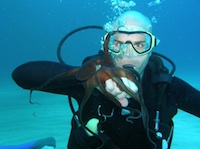Back to School with Discrepant Event Science!
 After a restful summer (which included a move to a new school!), classes are finally back in session! I always begin the year with a set of activities that challenge students to practice science process skills (observing, recording data, asking questions, etc.). My approach includes a series of quick “discrepant event” demos that captivate (and baffle) my students. From trying to figure out why two ice cubes melt at dramatically different rates to brainstorming explanations for how a sealed opaque balloon suddenly starts self-inflating, these demos engage students, assess students’ science skills, and emphasize the processes and habits that scientists use to inquire about the world around them.
After a restful summer (which included a move to a new school!), classes are finally back in session! I always begin the year with a set of activities that challenge students to practice science process skills (observing, recording data, asking questions, etc.). My approach includes a series of quick “discrepant event” demos that captivate (and baffle) my students. From trying to figure out why two ice cubes melt at dramatically different rates to brainstorming explanations for how a sealed opaque balloon suddenly starts self-inflating, these demos engage students, assess students’ science skills, and emphasize the processes and habits that scientists use to inquire about the world around them.
Asking Questions

My first demo begins with two black plates upon each of which I place an ice-cube. Within seconds, students notice a difference between what is happening to the ice cubes. As a puddle forms around one cube, the other remains solid ice showing now signs of melting. I then ask students to record two questions, the answers to which they think will help them understand the difference between the two ice cubes. Students share their questions (Are the ice cubes both made of the same substance? Is one plate hotter than the other?) and explain why they the answers to their questions will help them more fully understand what’s going on. After a few minutes of sharing (but not answering) questions, one student invariably suggests moving the not melting cube to the other plate. When it begins melting and students exclaim that it must be that the one plate is hotter than the other, I pass around the plate sitting under the rapidly melting cubes. To students surprise, it is not warm but instead ice-cold! We continue the discussion and questioning, eventually discovering that the plates are made of different materials (wood vs. metal) and discussing conduction and relative temperature. In this 20-minute investigation concludes with a discussion of how asking questions helped us (and scientists) understand an unexpected phenomenon.
Ideas & Resources
My discrepant event introductory lessons typically include five different demos, each practicing a different skill (recording observations, asking questions, recording data, making predictions, etc.). Below are some of the materials I use in my classroom and resources on how to bring discrepant event science into your classroom.
From NSTA Press: Author Thomas O’Brien created his Brain-Powered Science series for educators who love to surprise and challenge their students with unanticipated results. Using his inquiry-oriented experiments based on the science of discrepant events—hands-on explorations or demonstrations in which the outcomes are not what students expect—teachers can challenge students’ preconceived ideas and urge them to critically examine empirical evidence, draw logical inferences, and skeptically review their initial explanations with their peers.
Ice Block Demo – As described and pictured above.
Self-Inflating Balloons – A sealed, opaque mylar balloon mysteriously begins to self-inflate
 Two-Balloon Surprise – Two balloons are connected by a valve. When the valve opens, the smaller balloon inflates the larger one.
Two-Balloon Surprise – Two balloons are connected by a valve. When the valve opens, the smaller balloon inflates the larger one.
Happy & Sad Balls – A ball suddenly stops bouncing after being secretly switched for one made of a non-elastic material
UV Detecting Beads – Beads change from colorless to vibrant colors, but only in some types of light.
Sinking & Floating Spheres – Two spheres with identical masses respond differently when placed in a bowl of water
Astro Blaster – A red ball mysteriously bounces five times higher than the height from which it was dropped.

